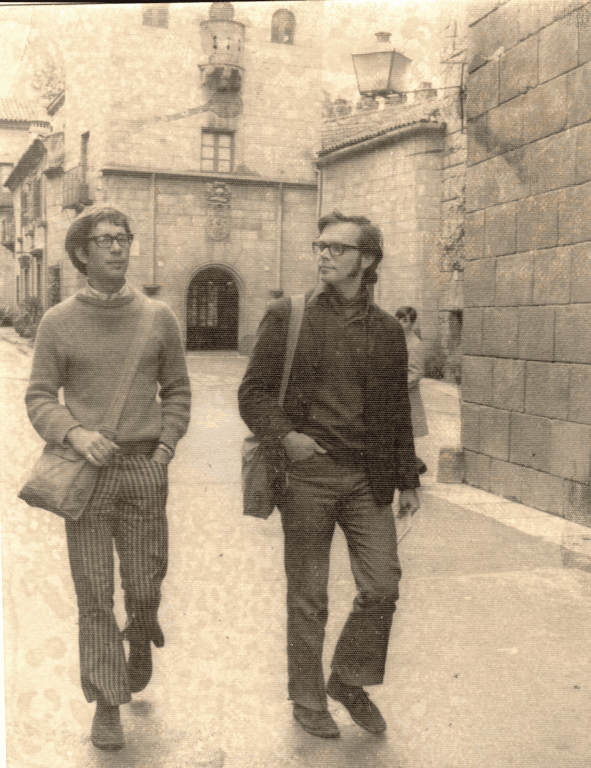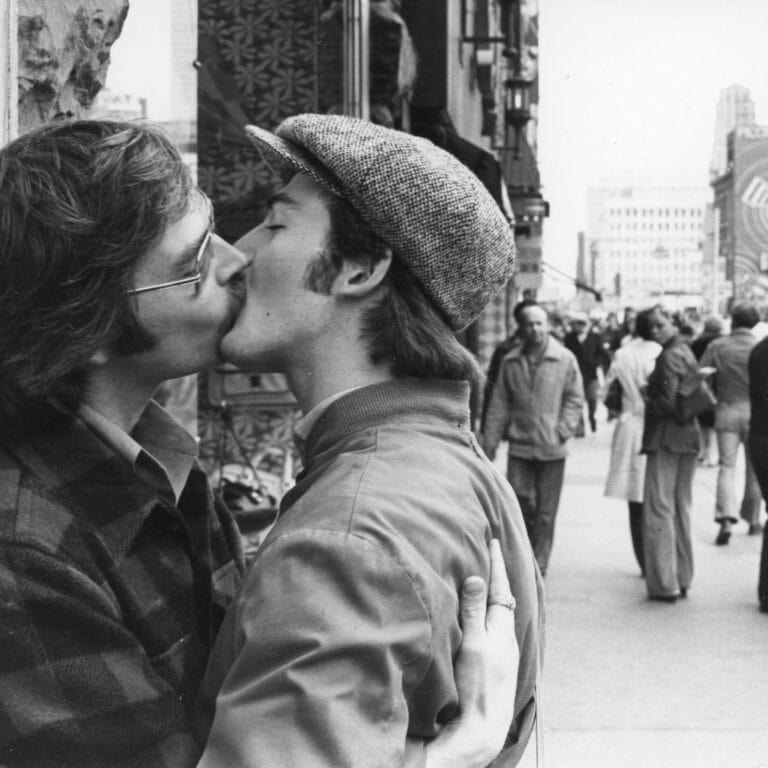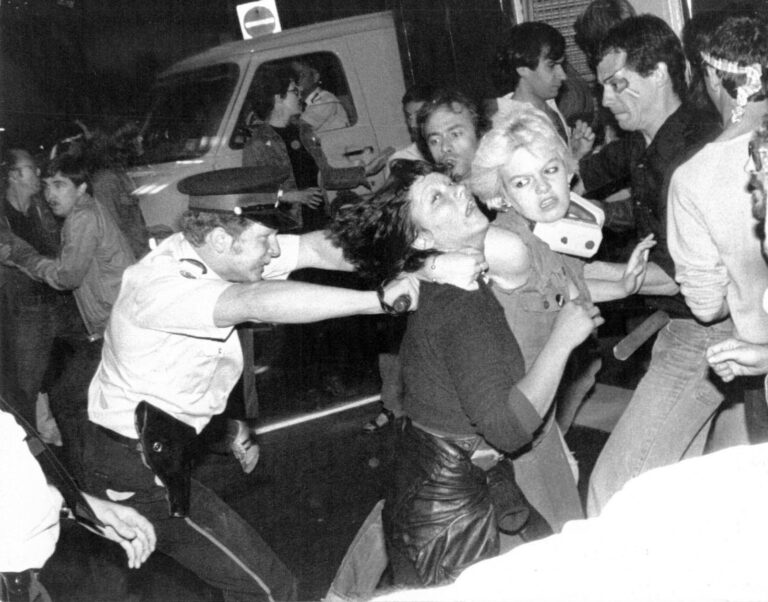Gerald Hannon was a fascinating public figure in Toronto’s LGBTQ2+ activism scene. His collection at The ArQuives is a window into the soul of queer life and love, all through the lens of an incredibly talented photographer and journalist.

An untitled image of Gerald Hannon on the beach.1
“It is a skill, oblivion. I have never lost it. I think sometimes that it is one of the reasons I am a good journalist- I have to make myself see, even today. I can never casually look about me- looking is always an act, willed, fresh, no longer frightened but rarely mechanical. I tell myself that I see things other people miss. I tell myself that I can still concentrate so intensely that the world will disappear.”2
– Gerald Hannon, Immoral, Indecent, & Scurrilous
Gerald Hannon was one of the most iconic photographers in Canada who captured queer history. He was most prominently known for his award-winning dissenting journalism and his contributions to The Body Politic, a publication that strived for queer liberation in the 1970s and 80s. He was also a professor, a sex worker, and a cherished friend of many. His work continues to be circulated among the LGBTQ2+ community at large, with many of his photographs being housed in The ArQuives.
During my time as an archival assistant at The ArQuives, I have focused on creating a digital exhibition of Gerald’s photography and his life’s work as an activist. As I write this, I am in the process of putting together the final pieces of the exhibition.
Admittedly, I did not know who Gerald was when I began my research. I was fascinated by descriptions of his character and his activism initially, and still am. Gerald Hannon was a remarkable man, one who led a fulfilling life while always staying true to his beliefs. He was charming, witty, and committed to the telling of untold truths within the queer community. Gerald is integral to the history of LGBTQ2+ activism in Canada. This piece will explore Gerald’s work as an activist, offering insights through the lens of archival research and reflection.

Gerald Hannon (left) and Ed Jackson (right) in Barcelona, 1971. Courtesy of Ed Jackson.3
Gerald’s relationship with activism began August 19th, 1971, in London, England. After attending a protest by the Gay Liberation Front with his friend Ed Jackson, Gerald and Ed began fervently discussing the issue of gay liberation in Canada.3 Upon returning to Toronto, Gerald purchased an issue of The Body Politic from collective member Paul Macdonald.4 This sparked his involvement with the publication- Gerald was involved in every The Body Politic publication from that moment until its closure in 1987.
His journalistic style was radical, in that he explored topics that many community members and journalists did not dare touch. Gerald crafted articles that centered the voices of those with untold stories. In “No Sorrow, No Pity,” he interviewed disabled members of the queer community and told their stories to an audience that otherwise would not have been accessible.6 He was also committed to giving a voice to youth and a platform to share their struggles, no matter the reaction of the reader.
Many know Gerald for the controversy that erupted in the aftermath of the publication of his article, “Men Loving Boys Loving Men,” which passionately and intellectually brought to light the lives and relationships of “men who love boys and boys who love men.”7 The aftermath of the article’s publication resulted in The Body Politic being subject to a police raid, as well as collective members Gerald, Ed Jackson and Ken Popert charged with “the use of the mails for the purpose of transmitting or delivering anything that is obscene, indecent, immoral or scurrilous.”8 Although the Crown offered Gerald the opportunity to plead guilty with the promise of no jail time or fine, he was staunch in his position that such a decision would affect his conscience and the credibility of The Body Politic. Instead, $100,000 was raised by The Body Politic Free the Press Fund to assist with legal fees. The three accused were engaged in a long and strenuous legal battle with the Crown, which eventually resulted in a not guilty verdict.
Although “Men Loving Boys Loving Men” was Gerald’s most notorious article of his career, he produced a number of award-winning pieces after his tenure with The Body Politic ceased, including gold and silver recognitions at the National Magazine Awards. He was a master of his craft, with the ability to draw his readers in with insightful reflections, radical assertions, and a quick sense of humor. His photography is equally as unique, with images that tell stories so intimately that the viewer feels as if they are experiencing the story within the photograph itself, if only for a moment.
Gerald began shooting and developing film out of necessity- The Body Politic required a photographer and he was willing to take on the task.9 Being a photographer at protests was a risky endeavor; the combination of police presence and an engaged crowd could be dangerous at worst and risk damage to the camera at best.10 However, similar to his work as a journalist, Gerald was committed to telling the stories of the LGBTQ2+ community as they faced police brutality in response to their activism in a way that was both raw and strikingly sophisticated. His portraits of his friends and collective members are similar, in that they tell a more intimate and vulnerable side of queer life that would have been shrouded in darkness if not for Gerald and his camera. His photographs are a direct reflection of his personal experiences as a gay man. They explore sexuality, moralism, and humanizing those most stigmatized by societal norms. With regard to technique, Gerald’s work is refreshingly honest, accompanied by simple photographic composition that draws attention to the subject(s). His use of light and shadow bring emotions to the surface of the image that draw the viewer in and make them feel as if they are part of the moment.

Ed Jackson and Merv Walker Kissing in Public, 1986, Gerald Hannon11
This photograph demonstrates Gerald’s ability to bring humanity and vulnerability to the forefront of a photograph. The composition of the image includes the reactions of passersby in the background, with his friends and The Body Politic members Ed Jackson and Merv Walker embracing passionately in the foreground. The inclusion of Ed’s hand placed gently on Merv’s back, and their subtle expressions of joy create an image that speaks to the infectious and exciting nature of queer liberation that Gerald and his colleagues experienced during that time, despite the stigma and negative reactions they may have encountered.

Third bath raid protest, June 20, 1981. The Battle of Church Street. Gerald Hannon12
In contrast to the previous image, the image shown here is a violent depiction of police brutality against the LGBTQ2+ community that occurred during the Bathhouse Raids in 1981. The community rallied against the police after several bathhouses were violently raided with the aim of arresting sex workers. Here, Gerald shoots from above, emphasizing the vulnerability of his subjects. The use of flash exposes the actions of the police officer and the reactions of fear on the women’s faces. Furthermore, the angle of the camera looks somewhat tilted, which contributes to the sense of disarray and chaos that the viewer feels when engaging with the photograph. In contrast to the previous photo, this image emphasizes the range of photographic techniques and style Gerald would employ when working in the field.
As the archivist researching Gerald’s work, I began by engaging with secondary sources. Gerald’s website is host to many of the articles he wrote during his career, as well as personal and political images.13 I also read his book, Immoral, Indecent & Scurrilous, which was truly insightful into knowing the forces that shaped him into the photographer and journalist that he became.14 With the support of reference archivist Daniel Payne, I requested access to his photographs and articles through The ArQuives collections using our online database. It can sometimes be challenging to know which images to request based on only descriptive information, but by discussing my ideas at length with our in-house archivist as well as the Executive Director, I was able to hone my ideas into an exhibition concept that utilizes Gerald’s photography in an accessible and informative manner. Of course, if I could peruse every image and article, I would. But with Gerald’s collection being quite extensive, the photographs I do use must be selected carefully.
The ArQuives plays an important role in preserving Gerald Hannon’s work. By making these photographs and articles accessible, the public is given the opportunity to learn more about queer history in Canada through the lens of one of the country’s most influential queer activists. I am grateful for the opportunity to contribute to this work, and especially honoured to be able to work with the Gerald Hannon collection.
By shamelessly risking controversy, Gerald opened doors for debate and conversation on many of the topics he wrote about. He provided a platform for marginalized individuals to share their stories, no matter how complex. He was committed to supporting queer youth, both as a writer and a professor. His legacy is shameless, provocative, and endearing. His photography and journalism will continue to educate the public on LGBTQ2+ history and show queer youth what previous generations faced in their fight for liberation, as well as the tender moments of intimacy that accompanied such a fight. In Gerald’s own words, “It was the best of the worst of times… it isn’t easy to convey how much fun we were having in the midst of all of it.”15
From his journey into activism to his photographic style, everything about Gerald’s work is authentic, much like himself. He has left us with an iconic legacy and incredible insights into the history of LGBTQ2+ liberation in Canada. The opportunity to work with the Gerald Hannon collection at The ArQuives has helped me better understand the history of my community and the people that drove queer activism forward while shaping Toronto into the place it is today. I encourage you to explore Gerald’s work in this exhibition, and The ArQuives collections more broadly. There is a plethora of material available, all of which provide valuable insight into the people and places that were and are essential to queer liberation.
References
- Unknown artist, Untitled, Photograph, Unknown date, (Gerald Hannon), https://geraldhannon.com/
- Gerald Hannon, Immoral, Indecent, and Scurrilous (Toronto: Cormorant Books, 2022), 22.
- Unknown artist, Gerald Hannon (left) and Ed Jackson (right) in Barcelona, photograph, 1971, The ArQuives, Toronto.
- Gerald Hannon, Immoral, Indecent, and Scurrilous (Toronto: Cormorant Books, 2022), 103.
- Ibid, 106.
- Gerald Hannon, “No Sorrow, No Pity: A Report on the Gay Disabled,” The Body Politic, February 1980.
- Gerald Hannon, “Men Loving Boys Loving Men,” The Body Politic, Issue 39, December 1977.
- Gerald Hannon, Immoral, Indecent, and Scurrilous (Toronto: Cormorant Books, 2022), 138.
- “Photos,” Gerald Hannon: Journalist, Accessed Aug 16, 2024, https://geraldhannon.com/photos/.
- Ibid.
- Gerald Hannon, Ed Jackson and Merv Walker Kissing in Public, photograph, 1986, The ArQuives, Toronto.
- “Photos,” Gerald Hannon: Journalist, Accessed Aug 16, 2024, https://geraldhannon.com/photos/.
- Gerald Hannon: Journalist, Accessed Aug 16, 2024, https://geraldhannon.com/photos/.
- Gerald Hannon, Immoral, Indecent, and Scurrilous (Toronto: Cormorant Books, 2022).
- Gerald Hannon, Immoral, Indecent, and Scurrilous (Toronto: Cormorant Books, 2022), 151.
Bibliography
Hannon, Gerald. Ed Jackson and Merv Walker Kissing in Public. 1986. Photograph. The ArQuives,
Toronto.
Hannon, Gerald. Immoral, Indecent, and Scurrilous. Toronto: Cormorant Books, 2022.
Hannon, Gerald. “Men Loving Boys Loving Men.” The Body Politic. December, 1977.
Hannon, Gerald. “No Sorrow, No Pity: A Report on the Gay Disabled.” The Body Politic. February, 1980.
Hannon, Gerald. Ed Jackson and Merv Walker Kissing in Public. 1986. Photograph. The ArQuives,
Toronto.
Unknown artist. Gerald Hannon (left) and Ed Jackson (right) in Barcelona. 1971. Photograph. The
ArQuives, Toronto.
Unknown artist. Untitled. Unknown date. Photograph. Gerald Hannon, https://geraldhannon.com/.
Author bio: Catherine Rose holds a BA (Hons) in Sociology and Indigenous Studies from Queen’s University. Her previous experience includes the development of educational curricula for Forests Ontario and her engagement with research for Rainbow Railroad. She has facilitated the distribution of community funding for United Way for the City of Kawartha Lakes and contributed to the digital growth of small businesses for Invest Kingston. At Queen’s University, she designed and curated an online exhibition on Indigenous-settler relations with the aim of encouraging community involvement. In her spare time, she volunteers for CAMH on matters of policy and youth engagement.

